Books
Books

Pictograms
A previously unpublished collection of 60 ink pictograms, drawn between 1976 and 1996, originally printed individually as A2 plane prints.
An early progenitor of the artist's book genre, Warja Honegger-Lavater was born in Winterthur, Switzerland in 1913. She worked as an illustrator for the magazine Jeunesse from 1944-1958, and moved to New York shortly thereafter where she began a wonderful series of artist's books.
These books were published between 1962 and 1971, an exceptionally ripe time for artists to turn to the bookform, a time when the most often cited "first" artist's book also appeared, Twentysix Gasoline Stations (1962) by Ed Ruscha.
All of Honegger-Lavater's books are made using the accordion-fold binding. Her aesthetic has been aptly described as "very clean, very Swiss." Each book tells a story, sequentially, like traditional books, but varying from them by rarely using words. Instead she chooses a symbol to represent, for example, a character, as in the red dot standing in for Red Riding Hood in Little Red Riding Hood.

Diary of Dreams
In 2013 Itziar Okariz exhibited Diary of Dreams for the first time. In its original iteration, the artist's daily recollection of dreams took on the form of a cumulative pile of notes.
Eventually, Okariz presented these notes as a vocal performance in which she multiplied the phrases, read the words repeatedly, and even inverted their syntax. The oral deconstruction of the narrative resulted in a fourth rendering of the dreams: the transcription of the performative reading into a book.
Limited edition of 250 numbered copies.
Trained in sculpture and painting at the University of the Basque Country, Itziar Okariz (born 1965 in Donosti-San Sebastian) has lived in New York and Bilbao. She has had solo shows at Sala Rekalde, Bilbao (2008), Singel International Kunstcentrum, Antwerp (2007), MUSAC, León (2014), Kunsthaus Baselland (2017), CA2M, Madrid (2018) and Tabakalera, Donosti-San Sebastian (2018).
Edited by Moritz Küng

Bruce Baillie: Somewhere from Here to Heaven
A scrapbook on Baillie's life and career, with stills, ephemera and writings by filmmakers across generations.
This is the first book on the West Coast avant-garde filmmaker Bruce Baillie (1931-2020), famed for the films Mass for the Dakota Sioux (1964), Castro Street (1966) and All My Life (1966) and for his influence on directors such as George Lucas (one of Lucas' charitable foundations helped fund the digital transfer of Baillie's films) and Apichatpong Weerasethakul. Alongside stills from Baillie's films, the book fosters a dialogue between Baillie and filmmakers and writers across several generations, including experimental filmmaker Peter Hutton, filmmaker and anthropologist J.P. Sniadecki and Jonas Mekas, along with suites of images by the Thai director Apichatpong Weerasethakul, British artist and experimental filmmaker Ben Rivers and Brazilian artist and filmmaker Ana Vaz, among others. Reproductions of correspondence and other ephemera are also included.

The Pepsi Cola Addict
The legendary lost novel in which fourteen-year-old Preston Wildey-King must choose between his all-consuming passion for Pepsi Cola and his love for schoolmate Peggy.
"He walked into the turbulent super market. There were people everywhere. His eyes swept over the shelves and stabilised on a large stack of Pepsi-colas. He could almost experience the cool fizzy liquid descending his parched throat."
Written by June-Alison Gibbons when she was only 16, The Pepsi Cola Addict is considered one of the great works of twentieth-century outsider literature. More than just a literary curiosity, however, this tale of a teenager whose passion for a well-known cola drink threatens to ruin his life is the uniquely vivid expression of a young woman trying to make sense of the confusing, often brutal world she in which found herself.
Published in 1982 by a vanity press who took £800 from its young author and gave her only a single book in return, it's thought that fewer than ten original copies still exist in the world.
Shortly after its publication, June-Alison and her sister Jennifer would become infamous as "The Silent Twins" and find themselves cruelly incarcerated for over a decade in Broadmoor Hospital. This author-approved edition makes June-Alison Gibbon's remarkable vision widely available for the first time.

Limn the Distance
Limn the Distance imagines decentralisation through the poetics of Bernadette Mayer and the concentric communities of one mountain. From major cities to art worlds, godheads to bodies and the spaces they inhabit, it asks what happens when we move away from the assumed nuclei of these knowledge and value systems. Orbiting around one mountain in upstate New York, Limn the Distance speaks of and through the communities that have resided there—from the radical sectarian shakers, and efforts towards communitarian living and small-scale farming that have happened in their wake, as well as the life and legacy of Bernadette Mayer who lived nearby. Through personal narrative and lyrical essay, the book draws on communitarian and artistic traditions of decentralised practice and resists the easy binarisms of solitude and sociality, ruralism and urbanism.
After hours in the dry heat of the polytunnel with its blue tarp and the warm and hopeless rotational pull of its fan system, we enter delirium—at the edges of our bodies—skin slick and supple with allium dust and sweat.
To know one’s place, to lose one’s place—
Years have unfurled—entire pandemics—since I began; began to depart from the original conception of my place, my writing, my body and began to know the edges of them—as limits, as possibilities—the lip, brink, shores of them; their fringes.
‘In her exquisite essay Rose searches for utopias and circles the Mountain. Home to the abstinent Shakers with their visions as gifts; farming (also a gift) and the relationship between Rosemary and Bernadette Mayer (double gift). The utopias here are all approximate, the quest personal, the Mountain real. Limn The Distance is glittering and beautifully stitched as Rose seeks alternative economies (of friendship and feminism, for how to live now). Her first book is an awakening borne of art and agriculture, theory and poetry— all on the border of this Mountain.’ - Jennifer Kabat
Rose Higham-Stainton is a writer and critic interested in gender and art-making, material culture and resistance. Her work is held in the Women’s Art Library at Goldsmiths College and has been published by LA Review of Books, Texte Zur Kunst, Artforum, The White Review, Art Monthly, X-Tra, Bricks from the Kiln, Apollo, MAP Magazine, and Worms. She has written several chapbooks. Limn the Distance is her first book.

The Lives of the Artists
The more I think about it, art theory is no place for straights. And contrary to popular opinion you can’t be really poor—or poor without a safety net—and bohemian. Or live in a capital city and have a fun time all the time or even some of it. There was no good reason why Someone Else and I split up besides different senses of humour and views on economics - which are two no good major reasons...
'In Vasari’s soaring vision of art, the most-used adjective is ‘beautiful’. In Finlay’s tarmac-hugging account it is ‘posh’. This book is not an appraisal of perfection of an artist’s output, but a rummage through an improvised life full of so much besides art. What a wry, unsparing weave of formative episodes and structural ironies. What devil-may-care tilts at authority. No redemption or overcoming all odds here! This unvarnished world is marbled through with brilliance and shit.' — Sally O’Reilly
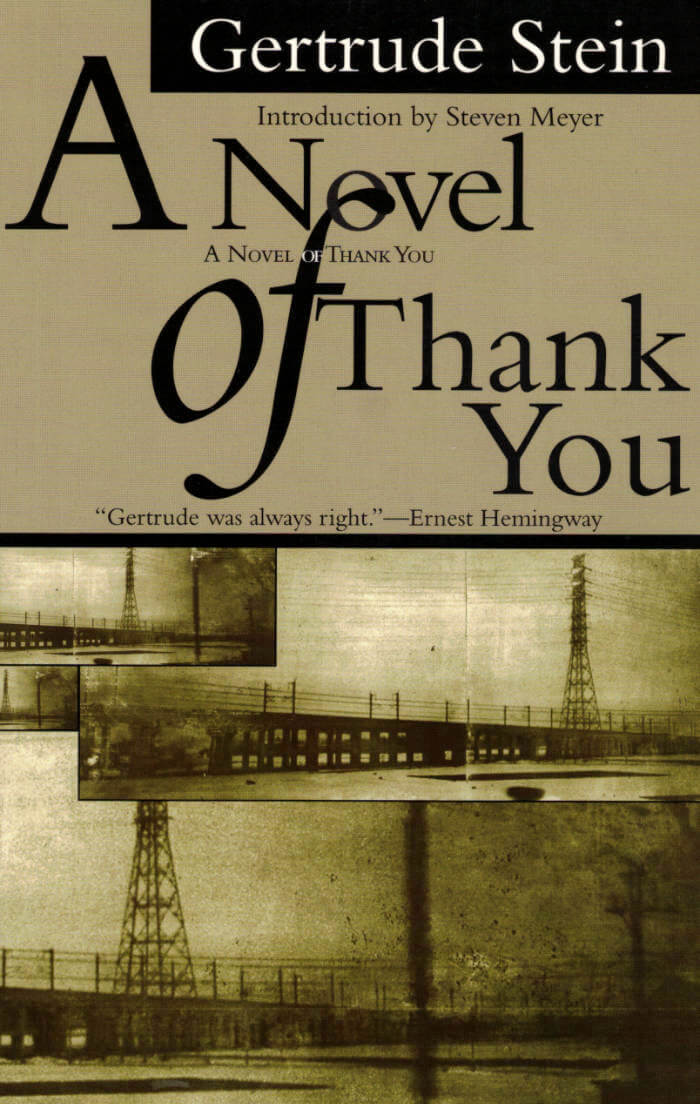
A Novel of Thank You
This is the first paperback edition of one of Stein's most revealing novels. Written in 1925-26 (but not published until 1958), it is Stein's midcareer assessment of herself, her writing, and her relationships, composed in the unique style for which she is celebrated.
In place of a traditional narrative, Stein explores the nature of narrative, its possibilities, the various genres (historical novels, the novel of manners, adventure stories) available to the writer, the conventions of novel-writing, and the novelist's relation to her materials. In a sense, the novel is about preparing a novel (the subject of chap. 50), about everything that goes through a writer's head as she begins to write.
Mixed in with her meditations on writing are daily events in her marriage to Alice B. Toklas, visits from friends - including such notable figures of the period as Josephine Baker, Virgil Thomson, Rene Crevel, and a number of expatriate American writers and artists - travels in and around France, memories of the past, inquiries into names and the nature of identity, and virtually anything else that occurs to her.
As she writes at one point, It can easily be remembered that a novel is everything, so everything of interest to Stein goes into her preparations for the novel that is A Novel of Thank You.

Presentable Art of Reading Absence
The Presentable Art of Reading Absence takes as impulse the act of meditation, in which the energetic relationship between a meditative body and its universe is not only the envisioning of absence by presence but also vision itself: "Here begins the revelation of a kiosk."
With occult emotionality and analytic brilliance, Jay Wright has written the user's guide to evanescence: "I have become attuned / to the disappearance of all things / and of my self . . ."

Dodge Rose
Eliza travels to Sydney to deal with the estate of her Aunt Dodge, and finds Maxine, a hitherto unknown cousin, occupying Dodge's apartment. When legal complications derail plans to live it up on their inheritance, the women's lives become consumed by absurd attempts to deal with Australian tax law, as well their own mounting boredom and squalor. The most astonishing debut novel of the decade, Dodge Rose calls to mind Henry Green in its skewed use of colloquial speech, James Joyce in its love of inventories, and William Gaddis in its virtuoso lampooning of law, high finance, and national myth.
Jack Cox was born in Sydney, Australia, and holds a Master's degree from the University of Sydney. In 2012, he studied in Paris as the recipient of a Marten Bequest scholarship. Dodge Rose is his first novel.

A Community Writing Itself: Conversations with Vanguard Writers of the Bay Area
A Community Writing Itself features internationally respected writers Michael Palmer, Nathaniel Mackey, Leslie Scalapino, Brenda Hillman, Kathleen Fraser, Stephen Ratcliffe, Robert Glück, and Barbara Guest, and important younger writers Truong Tran, Camille Roy, Juliana Spahr, and Elizabeth Robinson. The book fills a major gap in contemporary poetics, focusing on one of the most vibrant experimental writing communities in the nation. The writers discuss vision and craft, war and peace, race and gender, individuality and collectivity, and the impact of the Bay Area on their work.
Sarah Rosenthal grew up in Chicago and lives in San Francisco. She is the author of three chapbooks: How I Wrote This Story (Margin to Margin, 2001), SITINGS (a+bend, 2000) and not-chicago (Melodeon Poetry Systems, 1998). Her poetry and fiction have appeared in numerous journals and have been anthologized in BAY POETICS (Faux Press, 2006) and hinge (Crack Press, 2002). She has taught creative writing at Santa Clara University and San Francisco State University. She has edited a collection of interviews entitled A Community Writing Itself: Conversations with Vanguard Writers of the Bay Area. She is the recipient of the Leo Litwak Award for Fiction and grant-supported writing residencies at the Vermont Studio Center and the Ragdale Foundation.

Livre d'images sans images (LP, collector's edition)
Mette Edvardsen, Iben Edvardsen
Livre d’images sans images by Mette Edvardsen & Iben Edvardsen borrows its title from a book by H.C. Andersen, also referred to as The Moon Chronicler. The book follows a conversation between a painter and the Moon, where the Moon describes to the painter what she sees on her journey around the world every evening, telling the painter to paint what she describes. “This conversation, as in the now obsolete meaning of the word (‘a place where one lives or dwells’), was the starting point for our work. Using the weather report as dramaturgy, (‘the moon did not show up every evening, sometimes a cloud came in between’), we have created and collected materials from our conversations in the form of recordings, text, voice, drawings, references, found images, loose connections, inspirations and imaginations, in the order they came to us. They are at the same time sources and traces, material and support for new imaginations or events to come.” The work consists of three different media: vinyl, paper and live performance.
Mette Edvardsen is a choreographer and performer eager to explore the performing arts as a practice and situation, also in relation to other media such as books and writing. This work is in collaboration with her daughter, Iben Edvardsen.
Published by Xing & Varamo Press
XONG collection – artist records XX10 (2023)
First edition, September 2023
Recorded and edited by Mette Edvardsen & Iben Edvardsen
Format white 12’ vinyl LP in cardboard sleeve
Released in a numbered edition of 300 copies, including collector’s edition of 25 copies, each accompanied by a unique poster hand drawn with black marker by Mette Edvardsen & Iben Edvardsen, 59,4 x 84 cm, folded, signed by the artists

Chi Ban Lon: Queer & Sexuality Lexicon
Chỉ Bàn Lộn is a collection of Vietnamese queer and sexuality slang collected by artist ĐINH Thị Nhung and translated into English while working with Tường Vy and other participants of the Bàn Lộn-Vagina Talks project.
Born in Saigon in the mid-1980s, Tường Vy is a transgender queer who has been subject to a great deal of harassment, especially by the police during gatherings around public gardens. She and her friends’ experiences have led to a rich vocabulary to discuss sensitive topics related to their ‘professions’, preferences, and sex life. The main part of the Chỉ Bàn Lộn lexicon, ‘Saigonese pede 8x’, is related to their creation of linguistic safe spaces, and the rest of the publication outlines different ways to indicate parts of the body and how to talk about sex in the contemporary Vietnamese context.

High Shine
High Shine is boek zes van de groeiende collectie van De Nieuwe Dansbibliotheek en boek nul van de Notebooks die opgezet zijn door de fellows van THIRD, het derde cyclus onderzoeksprogramma van DAS Graduate School, ondersteund door DAS Publishing (lectoraat van de Academie voor Theater en Dans) en gefinancierd door de Quality Funds.
Als co-publicatie van DAS Publishing en De Nieuwe Dansbibliotheek, luidt High Shine een nieuw partnerschap in tussen nieuwe platforms en oude vrienden.

Livre d'images sans images (LP)
Mette Edvardsen, Iben Edvardsen
Livre d’images sans images by Mette Edvardsen & Iben Edvardsen borrows its title from a book by H.C. Andersen, also referred to as The Moon Chronicler. The book follows a conversation between a painter and the Moon, where the Moon describes to the painter what she sees on her journey around the world every evening, telling the painter to paint what she describes. “This conversation, as in the now obsolete meaning of the word (‘a place where one lives or dwells’), was the starting point for our work. Using the weather report as dramaturgy, (‘the moon did not show up every evening, sometimes a cloud came in between’), we have created and collected materials from our conversations in the form of recordings, text, voice, drawings, references, found images, loose connections, inspirations and imaginations, in the order they came to us. They are at the same time sources and traces, material and support for new imaginations or events to come.” The work consists of three different media: vinyl, paper and live performance.
Mette Edvardsen is a choreographer and performer eager to explore the performing arts as a practice and situation, also in relation to other media such as books and writing. This work is in collaboration with her daughter, Iben Edvardsen.
Published by Xing & Varamo Press
XONG collection – artist records XX10 (2023)
First edition, September 2023
Recorded and edited by Mette Edvardsen & Iben Edvardsen
Format white 12’ vinyl LP in cardboard sleeve
Released in a numbered edition of 300 copies, including collector’s edition of 25 copies, each accompanied by a unique poster hand drawn with black marker by Mette Edvardsen & Iben Edvardsen, 59,4 x 84 cm, folded, signed by the artists
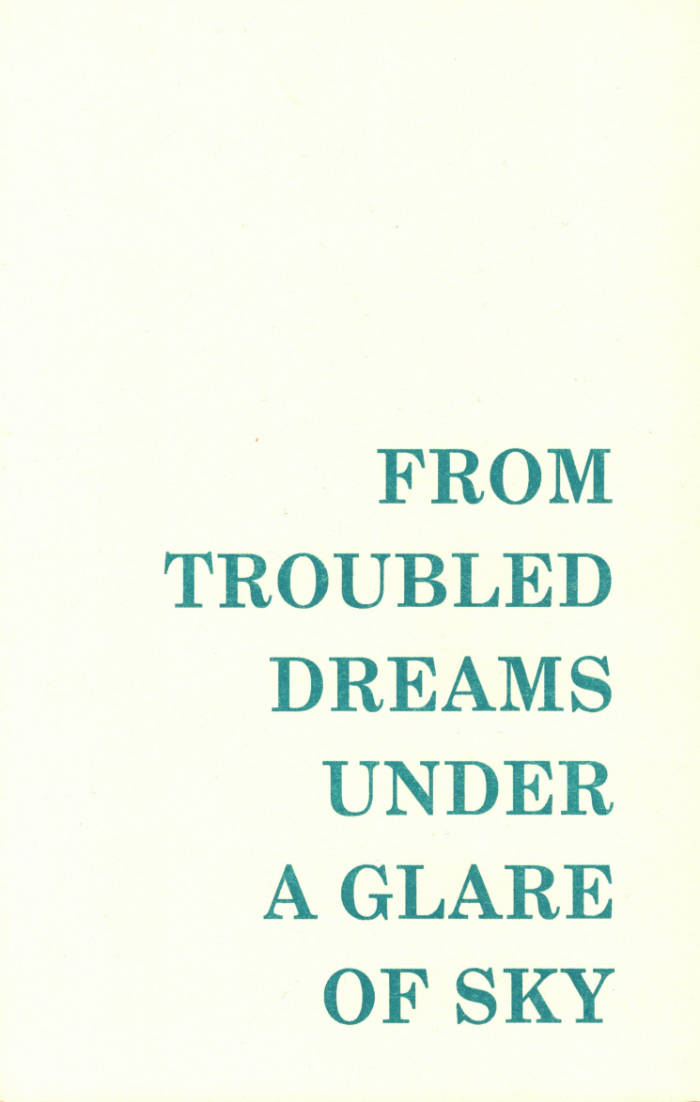
Edinburgh International Film Festival
From Troubled Dreams Under A Glare Of Sky
From under the luminous glare of the laptop and cinema screen, From Troubled Dreams Under A Glare Of Sky gathers newly commissioned essays from nine writers in Scotland, exploring ideas of cinema and metamorphosis.
Considering films in the programme of the 76th Edinburgh International Film Festival (EIFF) and beyond, the texts ranging in style, form and focus-encompass dreams and awakenings, the fatigue of cultural production, queerness and transness, Blackness and sacred spaces, and depictions of the immigrant. Each text creates space to understand, to make sense of what is on screen and what is out of frame.
Filmmakers discussed include Kelly Reichardt, Cauleen Smith, Celine Song, Paul B. Preciado, Babak Jalali, Liu Jian, Ng Choon Ping and Sam H. Freeman, Huw Lemmey and Onyeke Igwe. Expanding on an eclectic array of new and retrospective cinema, the collection seeks to introduce readers to a burgeoning Scottish scene of fresh voices in film and cultural criticism.
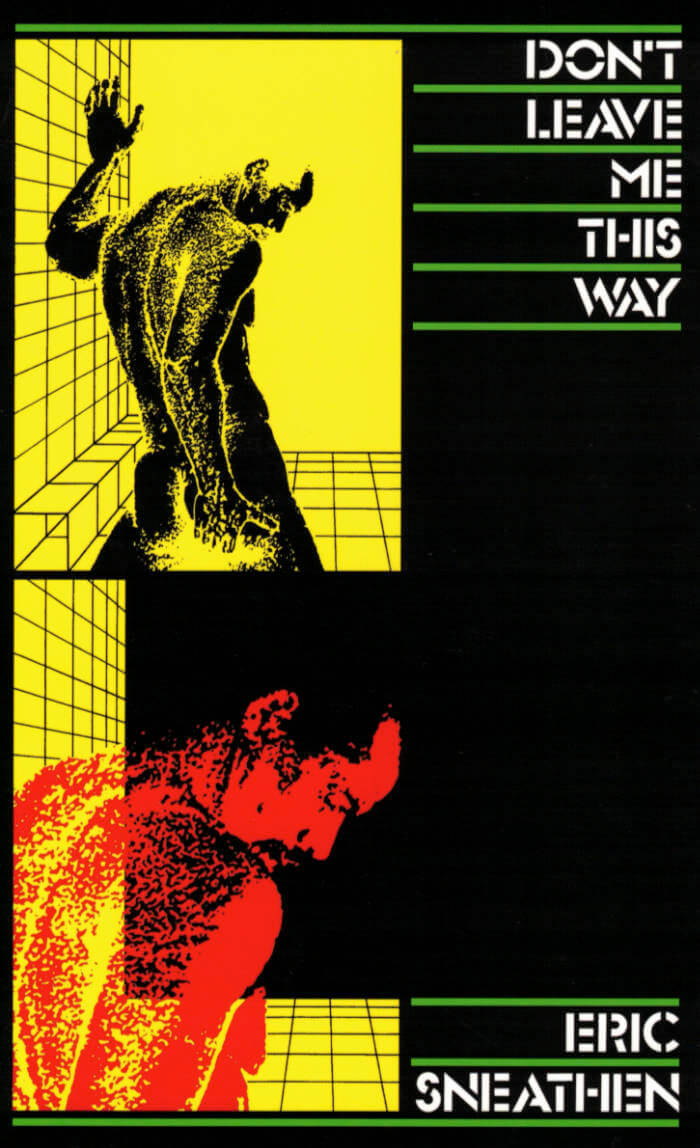
Don't Leave Me This Way
A textual and historigraphical odyssey imbued with queer intergenerational yearning and loss.
Don't Leave Me This Way blends archival research with sexual fantasy to produce a series of sonnets inspired by Gaétan Dugas, named by Randy Shilts as "Patient Zero" of the AIDS epidemic in North America. Committed to the utopian possibilities of elegy and pornography, Don't Leave Me This Way exploits the absurdist beauty of the cut-up technique to voice a chorus of lost spirits: poignant, vengeful, and ready to ball.
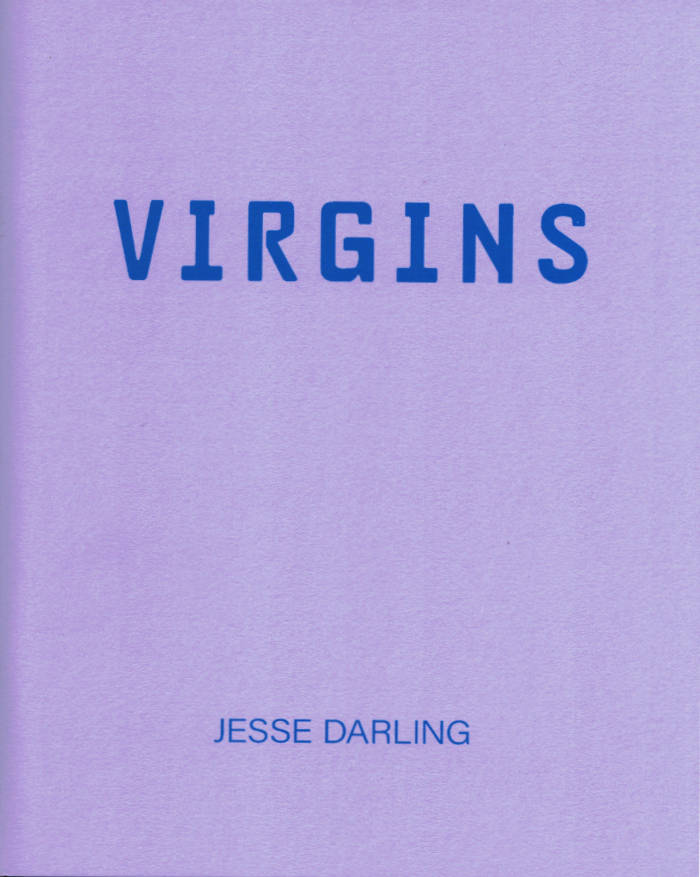
VIRGINS
Experiential and mapped, VIRGINS takes us on car rides, through hotel rooms and up close to meat viscera and enamel structures. Oscillating through binaries, concepts of innocence and experience are dragged by their creaturely haunches by ‘gathered clumps’ of characters who play, fight, bathe, fuck and browse on the burning pyre of old ideas.
‘Jesse Darling’s poems sing from the scrappy corners where life still lives. And they pray. Darling reminds us that between the beer and a cigarette there’s always a moment to genuflect on the street. There’s always a fire to stand around, too, bottoms up to the miracle.’ — Anne Boyer

Amends
Amends by Tim Etchells is a selection of texts haunted by performance but written for the page. In three uncanny acts, Amends exhausts the inauthentic languages of device, correction and apology, while remaining deeply sorry.

Deceit
Appearing for the first time in English, Deceit is the debut novel by Yuri Felsen, a leading modernist writer of the interwar Russian diaspora. Known by his contemporaries as ‘the Russian Proust’, Felsen died in the gas chambers at Auschwitz, his life and legacy destroyed by the Nazis.
Written in the form of diary, Deceit is a psychological self-portrait of an unnamed narrator, a neurasthenic and aspiring author, whose often-thwarted pursuits of his love interest and muse provide the grounds for his beautifully wrought extemporizations on love, art and human nature. Modulating between the paroxysms of his tormented romance and his quest for an aesthetic mode befitting of the novel he intends to write, Deceit is a remarkable work of introspective depth and psychoanalytic inquiry.
Quite unlike any other writer in the Russian canon, Felsen evokes in rich, poetic, idiosyncratic prose not only the Zeitgeist of interwar Europe and his émigré milieu, but also its psychology and the existential crisis of the age. What Nabokov achieves with images and the physical world, Felsen does with the emotional and metaphysical.
Translated by Bryan Karetnyk
With a Foreword by Peter Pomerantsev
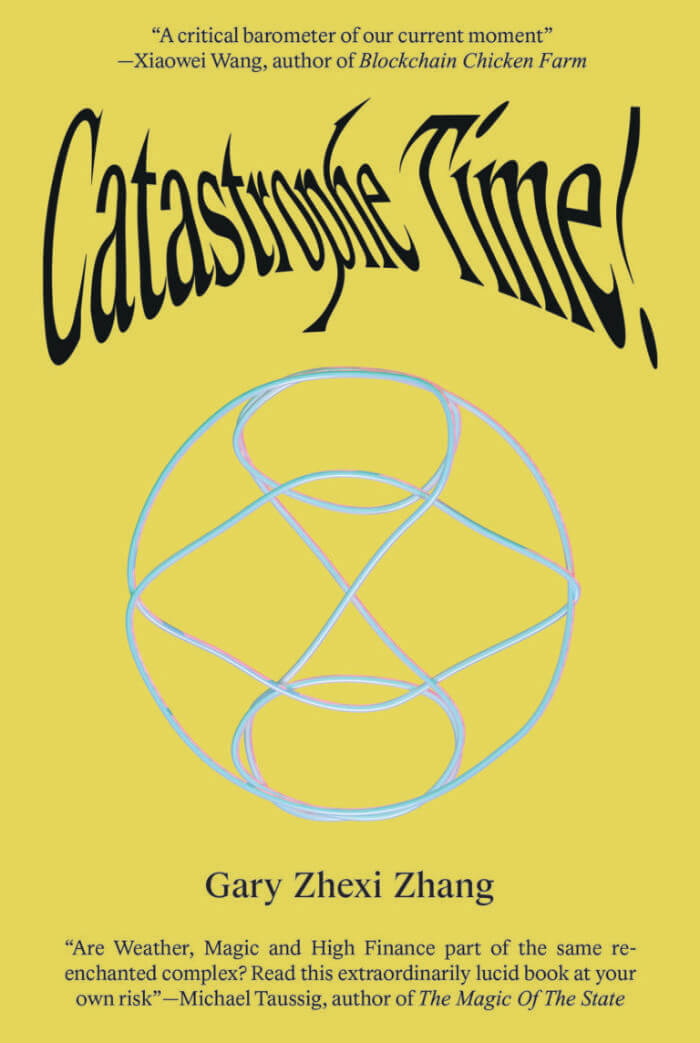
Catastrophe Time!
A collection of essays, fictions, and interviews exploring the weird temporalities of finance and catastrophe.
Once, financial practitioners plied a hybrid trade as hydrologists, star-gazers, and weather-watchers who sought to discover the natural laws of value and exchange as they did the divine order of an unchanging nature. Today, corporate firms hire trend forecasters and scenario planners to play out strategic fictions in virtual worlds. Hurricane insurance markets simulate a turbulent climate to offer investment instruments to hedge against the risks of the stock market. And for financial astrologers operating in the city of London, celestial motions provide a cosmic map that orients the mood of terrestrial markets.
Bringing together artists, researchers, and interstitial practitioners, Catastrophe Time! pays attention to the conditions of speculative knowledge on an increasingly volatile planet. Traversing a gray zone between rigorous research and operative science fictions, its contributors question how practices of speculation may transform, undermine, and at times exceed, the worlds they set out to model.
Edited by artist Gary Zhexi Zhang, Catastrophe Time! explores the power of temporal technologies—whether currencies, conspiracies, or simulation models—to shape reality through fiction. By bringing together researchers and writers working at the boundaries of temporal practices, including Diann Bauer, Philip Grant, Bahar Noorizadeh, Habib William Kherbek, Klara Kofen, Kei Kreutler, Suhail Malik, Bassem Saad and Gordon Woo, this urgent volume seeks to make sense of the unraveling times in which we live.

England's Hidden Reverse: A Secret History of the Esoteric Underground
This newly expanded edition of England's Hidden Reverse, the classic exploration of the English esoteric musical underground that includes the first, and only, biographies of Coil, Current 93, and Nurse With Wound, is based on exclusive interviews and unprecedented access to all three bands' personal archives.
Together, these genre-defying bands and their circles represent the English underground in all its cultural, artistic, and sexual variety. Over four decades, the three intertwined groups have maintained a symbiotic, yet uneasy, relationship with the mainstream of popular culture, even as their music, beliefs, and practices have repelled them from it. Theirs was a clandestine scene whose work accents the many occulted peculiarities of Englishness that flow through generations of outsiders, channeling personalities as diverse as Aleister Crowley, Arthur Machen, Joe Orton, Shirley Collins, Björk, and Marc Almond. The story of this Hidden Reverse has, necessarily, remained a secret. Until now.
This new volume contains almost 100 pages of extra material culled from Furfur, a collection of interviews with musicians and artists whose careers intersected with the bands', initially published alongside Strange Attractor's first limited edition of the book.

Salamander's Wool
The involuntary whispering of the dew-harvest.
A grimoire carved in scarlet, SALAMANDER'S WOOL is the inaugural full-length collection of writing by V Manuscript, amalgamating a vast array of arcane rituals into an ensorcelling poetic corpus. To read SALAMANDER'S WOOL is to consort with spirits and scry with dæmons, a linguistic alchemy which transmutes both language and reader.
V Manuscript is a poet and scriptomancer living in New York City.

The Commune
A legend in his home country of Greece but virtually unknown abroad, The Commune is the final work of Marios Chakkas, composed in the months preceding his early death in 1972. Born under the Fascist regime and reared as a socialist revolutionary, The Commune is Chakkas' reckoning with the uncertainty of the past and the madness of the present as the military junta secures its position and the spirit of the socialist insurrection fades. Returning from political exile, Chakkas confronts the decay and ruin of his Athenian neighborhood as he recounts childhood gunfights in the streets, churches filled with asbestos, vanished comrades, and violent squabbles over memorials for executed partisans in his singular voice which swerves from scorching poetic indignation to gallows humor to metaphysical meditation.
Chloe Tsolakoglou is a Greek-American writer who grew up in Athens, Greece. A PhD Student in English and Comparative Literature at Columbia University, her work has been published in or is forthcoming by Denver Quarterly’s FIVES, The Adroit Journal, Cream City Review, and elsewhere.
Translated by Chloe Tsolakoglou

Computer Pictures
COMPUTER PICTURES is a collection of digital illustrations and 3D renders from the eponymous trade magazine, a journal for “Creators and Designers of Digital Graphics, Multimedia and Prepress Production” which ran from 1984 until 1995. A publication of relative obscurity, scant few issues are available online and even their physical archival presence is limited. Yet within the pages of this inauspicious magazine lies an incredible cache of beguiling artwork that peeks and probes at the limits and potential of emerging forms. The true brilliance of Computer Pictures was its complete disregard for pedigree and pretension in an egalitarian embrace of the computer-based picture. Bleeding-edge experiments from Stanford and SGI ran alongside the output of rank amateurs. Professors, professionals, and hobbyists coinhabited the pages together in a non-hierarchal free-for-all exploration. These works, a swirling array of photomontages, 3D renders, and digital illustrations, conjure an occluded future frothing at the margins, a brief moment when the horizon seemed opened, the heavens were leveled, and new icons were waiting to be forged.
Edited by Octavio Minestrone